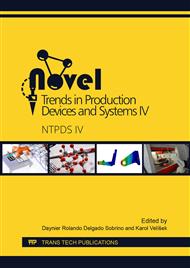p.182
p.190
p.199
p.207
p.215
p.222
p.230
p.236
p.246
The Application of Grinding of Ceramic Materials
Abstract:
An application of hard engineering materials depends especially on their specific properties, included mechanical properties and their machinability. Technical ceramics belongs to such materials. Nowadays, due to its properties, it is a process of grinding that is applied in machining. Because the technical ceramics has high hardness and brittleness it is important to pay attention to the whole process of machining. In this case of the grinding, there is need to pay attention to the process from disc engagement to grind off the desired layer. The paper deals with an implementation of grinding of ceramic materials in context of determining of elements of cutting forces and the surface roughness evaluation. These are important aspects for determining the suitability of the cutting conditions and the possibility of their use in the production process.
Info:
Periodical:
Pages:
215-221
Citation:
Online since:
April 2018
Price:
Сopyright:
© 2018 Trans Tech Publications Ltd. All Rights Reserved
Share:
Citation:


